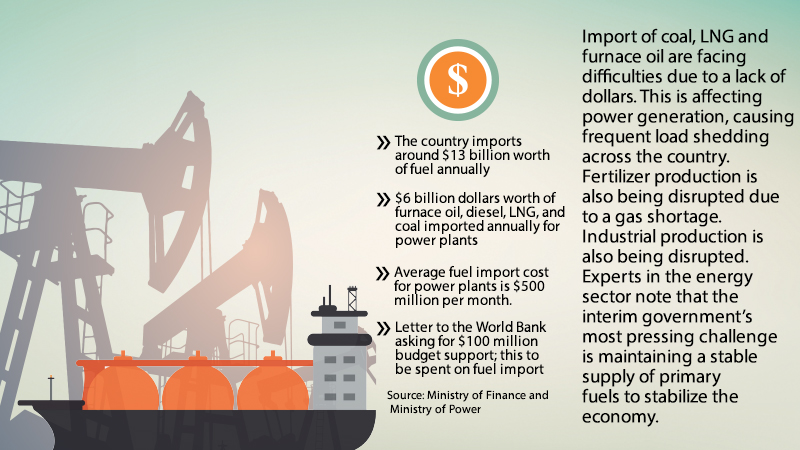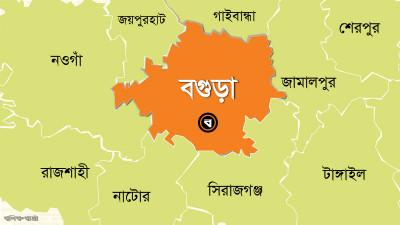 Photo: Bonik Barta
Photo: Bonik Barta Bangladesh
imports at least $13 billion worth of fuel annually, with nearly half of
it—around $6 billion—required for electricity generation alone. This cost is
expected to rise in the coming days; yet securing the necessary foreign
currency for fuel imports remains elusive. Electricity generation is being
disrupted due to inadequate imports of coal, LNG, and furnace oil. This is
causing frequent load-shedding across the country. Industries and various
sectors are also feeling the impact. Fertilizer production is severely affected
by the gas shortage. Experts in the
energy sector note that the interim government’s most pressing challenge is
maintaining a stable supply of primary fuels (oil, gas, and coal) to stabilize
the economy.
The
largest consumption of primary fuel in the country is in the power sector.
During the tenure of the Awami League government, planning in this sector has
largely focused on increasing production capacity. According to the Bangladesh
Power Development Board (BPDB), the total capacity of gas, coal, furnace oil,
diesel, and LNG-based power plants is now 25,738 megawatts, with the majority
of this capacity added in the past 15 years. However, while efforts have
focused on boosting production capacity, ensuring the necessary fuel supply for
these plants has been neglected. Investment, sufficient funding, and
infrastructure development in the energy sector have not been adequate to
support these power plants. Master plans have been drawn up primarily relying
on imported fuel.
Currently,
one-third of the total gas supplied to the national grid comes from imported
LNG. However, one of the two terminals required for LNG supply was closed for
three and a half months due to an accident, leading to a severe gas shortage.
Although both terminals are now operational, LNG is still not being supplied at
full capacity because Petrobangla has been unable to procure the necessary LNG
imports. The suspension of the Quick Enhancement of Power and Energy (Special
Provision) Act has also removed the option to quickly procure LNG from the spot
market through private companies. According to Petrobangla, it could take the
entire month to complete the tender process for importing LNG.
Md.
Kamruzzaman Khan, Director (Operations & Mines) at Petrobangla, told Bonik
Barta, “Summit’s LNG terminal has been reactivated, but full gas supply from
the terminal will not be available yet. They will only provide limited supply
from the reserve at their terminal. It could take until October 5-6 to achieve
full capacity.”
The
country’s gas-based power plants have a total capacity of nearly 12,500
megawatts, but only 5,500 megawatts are currently being produced. Petrobangla
estimates that running gas-based power plants at full capacity requires 2,300
million cubic feet of gas per day. However, even after accounting for plant
maintenance and the inefficiency of some power stations, at least 1,300 million
cubic feet of gas are still needed daily. Currently, the plants are receiving
an average of 800 to 900 million cubic feet per day, causing BPDB to keep many
plants idle due to the shortage.
Bangladesh
has fuel oil-based power plants with a capacity of 6,175 megawatts, including
5,885 megawatts from furnace oil-based plants and 290 megawatts from
diesel-based plants. These plants are producing only 1,000 to 3,500 megawatts
of electricity daily, leaving the rest idle. These types of plants have much
higher production costs compared to others. Excluding imported electricity, the
country’s coal-based power plants have a capacity of 7,179 megawatts. On
average, only 3,500 megawatts are being utilized, with over half of the
capacity remaining unused.
The
interim government recognizes the gravity of the fuel import crisis. To secure
funding for fuel imports, the government has already requested $1 billion in
budgetary support from the World Bank. Last week, the Economic Relations
Division (ERD) sent a letter requesting $500 million in two installments.
The
energy crisis has made it impossible to generate electricity according to
demand. Load-sheddings are occurring when electricity demand exceeds 13,000
megawatts. Muhammad Fouzul Kabir Khan, Adviser to the Interim Government on
Power, Energy, and Mineral Resources, is hopeful the situation will improve
within three weeks. During a discussion at the ministry on Wednesday, September
11, he said, “The current state of electricity will improve within the next
three weeks.”
Due
to the gas shortage, not only are power plants being shut down, but fertilizer
factories are also being affected. Over the past six months, three of the
country’s urea fertilizer factories have been closed one after another. Most
recently, production at the Hazrat Shahjalal Fertilizer Factory in Fenchuganj,
Sylhet, was halted yesterday (Friday, September 13). Currently, only the
Ghorasal Polash Urea Fertilizer Factory in Narsingdi remains operational. As
production falls short of demand, there is growing concern about fertilizer
supply for the upcoming Boro season, industry insiders say. There are also
doubts about meeting the target of producing 700,000 tons of urea this year due
to factory closures caused by the gas shortage.
According
to sources in the Energy and Mineral Resources Division, gas is a key raw
material for fertilizer production in the country. To maintain regular
production at the country’s five fertilizer factories, an average of 329
million cubic feet of gas is needed daily. However, the factories are only
receiving about 150 million cubic feet of gas.
At
least two senior energy sector officials told Bonik Barta that there is no
significant crisis in the global market affecting Bangladesh’s energy imports.
There are no major issues from suppliers either. If the necessary dollars and
letters of credit (LCs) for energy imports are settled, the energy supply will
remain steady. However, the energy sector currently requires more dollars. The
LCs that have been stuck need to be cleared as well. Without regular
transactions with suppliers, some level of crisis will persist.
According
to data from the Bangladesh Working Group on External Debt (BWGED), the total
production capacity of fossil fuel-based power plants in the country is 24,242
megawatts. In the 2023-24 fiscal year, peak electricity demand reached 16,477
megawatts. 56 percent of these power plants remain idle, yet still collect
large sums from the Bangladesh Power Development Board (BPDB) as capacity
charges. Each month, $500 million is needed to import fuel for these power
plants. Annually, the fuel import cost for these fossil fuel-based power plants
amounts to approximately $6 billion.
The
government, however, does not have the necessary foreign currency or dollars to
meet these needs. As a result, electricity production cannot be increased, even
as demand rises. Large coal-based power plants, in particular, are not
operating at full capacity. Although international coal prices have fallen,
imports are not possible due to the dollar shortage. Consequently, BPDB is
sometimes forced to shut down a unit or even an entire plant.
In
response to this, the government has taken a $500 million loan from the
Jeddah-based International Islamic Trade Finance Corporation (ITFC) to import
liquefied natural gas (LNG). For the first time, Petrobangla has taken this loan
for the 2024-25 fiscal year.
Asked
about the situation, energy expert and BUET Professor M. Tamim told Bonik
Barta, “It is impossible to completely stop importing primary fuel for the
power sector in the country. However, there is an opportunity to reduce
dependency. We need to increase local production of gas and coal, and there is
also scope to expand the use of renewable energy. Over-reliance on imports
creates pressure on foreign currency reserves. To reduce this pressure, we must
make rational use of the electricity capacity we’ve built into the grid.”






